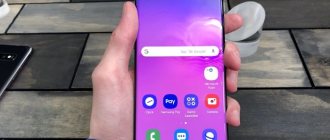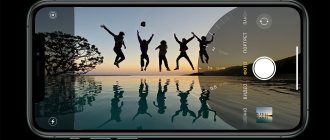OPPO continues to develop its line of relatively inexpensive and high-quality devices, clearly organizing products into three segments, which, unlike Xiaomi, are not so extensive: Reno class - mid-range devices, A-series - budget class and Find X - exceptional flagships .
OPPO focuses not only on technical specifications, but also on software, which in fact can be called the best among the shells of other smartphones.
Reno5 is a logical continuation of the previous Reno4 model, which acquired its own style, obtained through constant improvement of previous devices.
Ergonomics
The predecessor was clearly similar to the Huawei P40 Lite. First of all, this consisted of two front cameras and the design style of sloping edges. In Reno5, these points have been slightly reworked to make the smartphone different from its competitors. Of course, here you can still notice the influence of the Samsung S10e and Sony Xperia XZ Compact devices, but there is no talk of complete similarity.
On the front side there is a huge elongated display with a hole for the front camera. There is a cutout on the top of the frame for the earpiece. It is very thin and not very long. As it turns out later, for this reason it will not be easy to hear your interlocutor in an urban environment, despite the noise reduction.
The back of the smartphone is made of matte silver polycarbonate, which feels like a stone that has lain for several years in sea water. In the upper part on the left edge there is a transparent camera block with four modules, as well as a flash. This arrangement does not look very neat, since there is an imbalance in the sizes of the mono lens and the flash.
OPPO Reno5 is one of the few smartphones that has physical control buttons on both sides of the device. The left side contains separate volume control buttons and a tray for two NanoSIM cards and a microSD memory card up to 256 GB.
The right side has only one power button with a green mark, which has the property of becoming brighter in the light and remaining visible at night.
The frame around the entire body of the device consists of durable stainless aluminum alloy. The top end is equipped only with a microphone for noise reduction.
At the bottom end there are three cutouts for a multimedia speaker, a USB Type-C port, a conversational microphone, and a 3.5 mm TRS mini-jack connector. As such, there is no visual balance of ports and outputs for components - they are all at different heights.
Despite the screen size of 6.4 inches, the smartphone fits comfortably in the palm of your hand and in the pocket of regular jeans, without falling out or swaying from side to side. The smartphone does not seem huge, but due to its minimal edges, the device has a large, informative display.
Design and appearance
Oppo Reno 5 Lite is an excellent smartphone for the average person in terms of appearance. If you can't decide which color device is best for you, that problem doesn't exist here. Theoretically, the device I tested is blue-violet in color, but in practice, a lot depends on the angle at which the light falls on it and from which side you look.
The back can be blue, silver or pink. The plastic body is not bad, but, unfortunately, dirt, fingerprints and minor scratches are visible. In addition, plastic at this price point will not meet the expectations of some users. In general, the build quality of the Reno 5 Lite does not give much cause for criticism.
As for the location of buttons, ports, etc., on the left side there is a pull-out tray for SIM cards, just below there are volume keys. On the right edge you will find the device start button. The bottom edge is the place that Oppo has provided for the headphone jack, microphone, USB-C port and monaural speaker.
There is a circular punch hole at the top left corner of the screen for the selfie camera. On the back panel there is a protruding module with the main cameras. The dimensions of the Oppo Reno smartphone allow for trouble-free and comfortable one-handed operation. By modern standards, the Reno 5 Lite is not too big and relatively light.
Specifications
- Operating system: Android 11, Color OS 11.1 shell;
- Processor: Qualcomm® Snapdragon™ 720G;
- GPU: Adreno™ 618, 750MHz
- RAM: 8 GB, LPDDR4x, clock frequency 1866 MHz;
- permanent memory: 12 GB, UFS 2.0;
- Screen size: 6.43 inches (16.33 cm); usable area: 91.7%;
- resolution: 2400×1080 (FHD+); matrix type: AMOLED;
- Screen refresh rate: 90 Hz or 60 Hz;
- Touch sampling rate: maximum 180 Hz (2 fingers), default 120 Hz (5 fingers);
- Pixel density: 410 PPI;
- Brightness: 430 nits (typical); in sunlight brightness less than 600 nits (typical);
- main lens 16/64 MP: f/1.7; FOV 79.5°; focusing with feedback;
- ultra-wide-angle lens 8 MP: f/2.2; FOV 119°; fixed focus;
- 2 MP macro lens: f/2.4; FOV 89°;fixed focus;
- 2 MP mono lens: f/2.4; FOV 89°; fixed focus;
- front camera: 44 MP (f/2.4); FOV 85°;
- battery capacity: 4310 mAh;
- battery type: lithium-ion battery;
- fast charging VOOC 4.0, SuperVOOC, PD2.0, QC2.0;
- cellular communications (same values for two SIM cards): 2G: GSM 850/900/1800/1900 MHz; 3G: WCDMA bands 1/5/8; 4G: TD-LTE bands 38/40/41 (194MHz); 4G: LTE FDD bands 1/3/5/7/8/20/28;
- network: Wi-Fi 2.4 GHz, Wi-Fi 5.1 GHz, Wi-Fi 5.4 GHz, Wi-Fi 5.8 GHz, Wi-Fi display;
- Communication: Bluetooth v2.1 + EDR, Bluetooth v5.1;
- audio codecs: SBC, AAC, aptx HD, LDA;
- interfaces: USB Type-C, TRS 3.5 mini-jack, NFC;
- location determination: GPS, BeiDou, GLONASS, Galileo, QZSS, A-GPS supported;
- sensors and sensors: geomagnetic sensor, proximity sensor, optical sensor, accelerometer, gravity sensor, gyroscope, pedometer, hidden fingerprint scanner and facial recognition function;
- Height: About 159.1 mm;
- Width: About 73.3mm;
- Thickness: About 7.7mm (Black); about 7.8 mm (Silver) weight: About 171 grams;
- Contents: OPPO Reno5 smartphone, charging unit, headset, USB-USB Type-C cable, SIM card removal tool, booklet with warranty card, quick guide, case.
Like the previous OPPO Reno4 model, Reno5 is based on a single-chip system-on-chip Qualcomm Snapdragon 720G. Some users believe that the “G” prefix means support for fifth-generation 5G networks, but no, this chip still uses 4G cellular communications. The presence of such a letter only means higher frequencies.
The central processor consists of two clusters: 2 Kryo 465 (A76) cores with clock frequencies from 652 to 2323 MHz and 6 Kryo 465 (A55) cores from 300 to 1804 MHz. 8nm LPP (Low Power Plus) process lithography. Adreno 618 GPU clocked at 750 MHz.
The amount of RAM is 8 GB LPDDR4x type with a clock frequency of 1866 MHz. A 16-bit Dual Channel is used with a throughput of 14.9 Gbit/s.
In AnTuTu, the device scores 310,554 points. This is a good average result; the flagships of 2018 go further and higher.
Geekbench 5 showed 561 points in single-threaded mode (Single-Core) and 1607 points in multi-threaded mode (Multi-Core). Acceptable results for a regular smartphone, meaning fast opening of web pages and applications.
CPU Throttling shows a good result of the load process. Rare changes up to 95%, but otherwise the situation is positive.
PUBG Mobile runs on high graphics settings using high frame rates. Additionally, anti-aliasing and shadows are included for this purpose. Result: the game plays perfectly, without lags, crashes or any heating for 10 minutes.
The racing project Gameloft SE Asphalt 9 has high graphics settings. There are no problems with overheating, brakes, or crashes.
Unpacking and packaging
Oppo isn't following the trend of reducing bundled accessories to the bare minimum. The Reno 5 Lite is packaged in a slightly larger than average box, inside which you will find not only a charger and a SIM card removal tool, but also a silicone case and headphones.
The transparent case fits very tightly to the smartphone, and you need to make a little effort to put it on. I have no complaints about the headphones - they sound good for a complete headset.
Display
The screen size of OPPO Reno5 is 6.43 inches (16.33 cm). The display occupies 91.7% of the front side of the device. Touch sampling rate: maximum 180Hz (2 fingers), default 120Hz (5 fingers). Pixel density per inch: 410 ppi.
An AMOLED matrix is used with an image refresh rate of 90 Hz (default). Reducing the frequency to 60 Hz is possible, but you shouldn’t do it: the reduced screen refresh rate on this type of matrix is very noticeable. The maximum brightness level reaches 600 nits - not much, but in reality the picture looks richer and sharper than on an IPS matrix.
There is no protective film or glass installed out of the box. The oleophobic coating is excellent - it hardly collects fingerprints. The Always On Display function is available, in Russian in a smartphone it is designated as “Always on display”. The developers of the Color OS shell devoted most of their time to this option, which today has become a “feature” of any OPPO smartphone with an AMOLED/OLED screen.
The function has extensive settings, from which you can select “Custom templates”, “Text”, “Text and image”, analog or digital clock.
The lock screen features a light signal for notifications and incoming calls. This feature is seen in the Vivo X50 Pro and allows the smartphone to do without an LED indicator altogether.
Autonomy OPPO Reno 5 Pro 5G
Like last year's model, one of the key advantages of the OPPO Reno 5 Pro 5G is 65W fast charging. The 4350 mAh battery capacity is easily enough for an entire day of work.
There is no wireless charging, but a regular 65 W charger allows you to fully charge your smartphone in just 30 minutes. This is no joke - 30 minutes is enough to restore the battery level from 0 to 100%. The only negative is that the charger only works with OPPO phones. While the OnePlus 8T 65W adapter used the USB PD standard and was suitable for other devices, there is no such option here.
Software
In our humble opinion, the OPPO Reno5 smartphone is the best representative of the Android device family, which has collected advanced options for the “Personalization” tabs, as well as “Always-on display”. The control center interface includes blurring around the edges, encouraging the user to focus on notifications and service buttons. Notifications, unfortunately, are inseparable, but with clear sorting boundaries, grouped according to the type “Warning notifications”, “No sound signal”, “Conversations”.
The Color OS shell is attractive, since its add-ons are provided for users of different age categories. For example, as in the similar Realme UI firmware, the desktop can be set in accordance with consumer preferences - a sectional mode can be selected, divided into a desktop and a separate menu tab; standard mode – desktop window only; a simplified mode without a menu, where text and application scaling is applied - this type is suitable for visually impaired users or the elderly, as well as small children.
In the settings you can also find the inclusion of the options “Raise to activate” and “Turn on the screen with a double tap”.
The function of selecting all applications at once and the ability to transfer them to another desktop window is useful.
Since it uses an AMOLED matrix, it is possible to customize themes, wallpapers, Always-on display, icon styles, application layout, fingerprint button styles, colors, font sizes, notification panel, edge light.
There is an “Application Block” with tools, reflecting recently launched programs.
Floating windows and the ability to choose to share the screen with another compatible application are available. The first option is available when selecting a program from the “App Block”, and the second is through the three-finger swipe up gestures. A similar swipe, only downwards, takes a screenshot of the desktop.
There is a useful feature called “Icon Bar Eject Gesture” in Desktop Settings. It allows you to swipe from the left or right side at the bottom, thereby reducing and positioning applications to the appropriate corner. Thus, reaching the top program is not difficult.
The lock screen can be configured to turn on when you double-tap and lift from a table or any other surface when using the gyroscope. Each option has a companion tab for accessing other options.
Battery
The capacity of the battery installed in the gadget is 4310 mAh. Modest, considering that the standard for 2022 is 5000 mAh. Nevertheless, such a battery is enough for the device to easily withstand a whole day of active use. Owner reviews confirm this.
In addition, 30-watt fast charging is announced for it, due to which the device fully replenishes its resources in an hour.
Cameras
What the external camera unit looks like can be used to describe the performance of its functions among the lenses on the OPPO Reno5 smartphone - an ambiguous balance.
On the one hand, we are faced with excellent shooting at twilight and in low light, even without using night mode; on the other hand, we encounter incorrect exposure, poor saturation and contrast during daytime shots in cloudy or cloudy weather. When using two- or five-fold modes, we are pleased with excellent detail, true white balance, and a very clear image. At the same time, natural macro photography during the day seems slightly blurred even in the focusing area, but at night the camera manages to display almost all the details of the subject in great detail. There is also a perceived misdependency of artificial intelligence (AI) on sunlight.
The main camera with four modules is installed:
- 64 MP main sensor (Extra HD resolution increase using a neural network) with f/1.7 aperture, field of view FOV 79.5°; focusing with feedback;
- 8 MP ultra-wide-angle lens: f/2.2 aperture; field of view FOV 119°; fixed focus;
- 2 MP macro lens: f/2.4 aperture; field of view FOV 89°, fixed focus;
- 2 MP mono lens: f/2.4 aperture; FOV 89°; fixed focus.
Modes: night mode, video, photo, portrait mode, two-angle video recording function, slow motion, time lapse, AI Mixed portrait mode, Expert mode, Ultra HD, panoramic mode, text scanner, macro photography, stickers, soloop layouts, Google lens
Front camera 44 MP with aperture (f/2.4); FOV 85°. Modes: Night mode, video, photo, portrait mode, two-angle video recording function, slow motion, time lapse, AI Mixed portrait mode, panoramic mode, stickers.
The main camera can be used in two modes: 64 and 16.04 MP. Higher resolution is required to scale details correctly. There are no differences between them in color rendering and other shooting parameters. If the sunlight is bright, then this is reflected in the details - maximum sharpness and clarity of the contours of objects, low level or absence of sharpening, true white balance, lack of noise.
But if there is not enough sunlight, then the exposure suffers, the light sensitivity may be wrong, graininess and noise arise. When shooting vertically, the upper part of the frame remains blurred or has low sharpness. For horizontal – left or right sides.
The ultra-wide-angle lens does a good job of autofocusing in the center, there is acceptable detail, but there is a little sharpness, moderate grain, and small artifacts. There are noticeable distortions and areas of blur at the edges of the frame. Distant plans are distinguishable, but only the outlines of objects remain clear for perception.
Increased brightness and contrast are observed. Due to the low camera resolution, you shouldn't hope for more. The module also depends on sunlight and in good weather the saturation and contrast are a B minus.
The 2x and 5x shooting modes are virtually flawless. Almost without roughness, excellent detail, but with a transition of saturation to dark tones. It is possible to enlarge the image up to ten times, but the image is greatly deteriorated.
There are two types of macro photography: with the presence of artificial bokeh mode and natural. Natural mode is set on the main camera with a resolution of 16.04 megapixels; in this case, the distance to the object exceeds 4 cm - usually 15–20 cm - in order not to cause overexposure and blur in the focus center.
Artificial, or ultra-macro mode, occurs on a separate module, which creates intentional blur at the edges of the image and additionally a slight barrel distortion on the left side of the frame, where the corner field of the image is distorted. Simply put, this is the fisheye effect. Its exposure is weak, saturation is dark, artifacts and blur are noticeable, detail and sharpness are also quite low.
Portrait mode on the main camera works fine. The detail, depth of field, and saturation are good even on a cloudy day, but the camera excessively increases light sensitivity, making the photos look unnatural.
Portrait mode on the front camera is worse. When you zoom in on the image, you can notice blur even in the center of focus, good detail, but low sharpness, and white balance leaning toward cool tones.
Night mode is characterized by increased shutter speed. The camera is highly dependent on lighting and selects light sensitivity settings accordingly. The main camera shows slight noise, graininess, blur, and visible detail. Not bad for a sub-flagship.
On an ultra-wide-angle module, due to capturing a larger degree of viewing angle, the image is pulled back slightly from the focus center, therefore, if there is not a sufficient light source, there will be underexposure; then low brightness and long exposure times are possible. As a result, without a tripod, severe blur is possible. We also note artifacts, noise and graininess. Detailing, as well as sharpness, is low, especially at the edges of the frame. There are no chromatic aberrations.
Zooming in 2x and 5x improves things a bit, but it just depends on where the light source is from the center of focus.
Video can be shot in either 1080P/60 FPS or 4K/30 FPS. There is electronic stabilization, but only for 1080p/30 FPS. Artificial intelligence mode and ultra-wide-angle shooting are available. The main module provides seamless image enlargement. There is a super-stabilization mode.
Interfaces and network
The OPPO Reno5 smartphone has a slot for two NanoSIM format SIM cards and a microSD memory card up to 256 GB. One radio module is installed in the device, so the signal operation mode is alternating.
The following cellular parameters are supported: 2G GSM 850/900/1800/1900 MHz, 3G WCDMA bands 1/5/8, 4G TD-LTE bands 38/40/41 (194 MHz), 4G LTE FDD bands 1/3/5/7 /8/20/28. Three or four connection levels out of five are available; the check was carried out through the operators Tele2 and MTS.
Wi-Fi networks are supported in the following frequency ranges: 2.4 GHz, 5.1 GHz, 5.4 GHz, 5.8 GHz, and a Wi-Fi display is also implemented. The Bluetooth module uses versions v2.1 + EDR and v5.1. Audio codecs available: SBC, AAC, aptx HD, LDAC. There is an NFC module, contactless payment via mPOE terminals is possible.
⇡#Communications and wireless communications
OPPO Reno5 works with LTE networks, and the manufacturer, as is now customary, does not name the speed of the modem. But at least he names the ranges with which he works - everything is good here and, from personal impression, stable.
Slot for two nano-SIM cards and one microSD card
All necessary wireless modules are in place: Wi-Fi 802.11a/b/g/n/ac, Bluetooth 5.1, NFC (with Google Pay), navigation module with GPS, A-GPS, GLONASS, BeiDou and QZSS.
Sound
One voice speaker and one multimedia speaker are installed. There is no stereo mode support. Due to the fact that the voice speaker is thin and small in size, it will be difficult to hear the interlocutor even with a noise-canceling microphone, especially in places where there is a busy road or active construction nearby. However, audibility in quiet places is good, and it is possible to distinguish the timbre of the interlocutor’s voice.
The multimedia speaker is loud, rich, clear, with good bass, but a bias towards high frequencies. Sometimes at maximum volume the tonality becomes metallic. You can listen to music without headphones, and this is quite pleasant for a comfortable pastime. In wired headphones (analog signal), the volume seems quiet, less bassy. Wireless devices that support the LDAC codec do not experience any of these problems.
Dolby Atmos technology is supported with various sound effects for a specific situation. There is no equalizer. In the original headphones the sound is quiet, the bass is not felt.
Musical Features
Let's start with the cons: OPPO Reno5 does not have stereo sound. I still can’t understand why OPPO puts stereo in budget smartphones and flagships, but at the same time bypasses the average one.
The multimedia speaker is of good quality, the sound is clear, there are almost no artifacts. OPPO Reno5 also supports high-quality audio playback using LDAC and aptx HD codecs.
The sound quality over both wired and wireless connections is good. For this smartphone, I recommend buying OPPO Enco X , which are still not represented on our market.
Battery
The OPPO Reno5 smartphone has a 4310 mAh lithium-ion battery. Since the device has an AMOLED display from Samsung, battery power consumption is minimal. In passive mode, the discharge is 213 mA, and in active mode (using the desktop, simple applications) no more than 1A. But the device will remain turned on only until the end of the day.
When running games, from arcade to the heaviest, the smartphone can last no more than 6–7 hours.
VOOC 4.0 Flash Charge fast charging technology is used. Maximum output power 65W. This uses a voltage of 10 V and a current of 6.5 A. However, in reality, the DevCheck Pro application shows an input current of 9 A up to 50% of the capacity. At the same time, the smartphone hardly heats up, and the charge occurs in no more than 40 minutes.
OPPO Reno5 performance
The “engine” of OPPO Reno5 is familiar to us from Vivo V20 , Snapdragon 720G tailored for games, 8 GB of RAM and 128 GB of ROM. The set of characteristics is quite good.
If we compare it with its competitors, it is completely on par with the Vivo V20, both in terms of performance and throttling. If you compare it with the Galaxy A72, you will notice that the hardware is also similar, but the Korean costs 5 thousand more.
OPPO Reno5 runs all possible 3D games at high settings of 60 fps. During the game, the smartphone heats up noticeably, but at the same time it is still comfortable to play, in other words, it does not burn your hands.
I can also say that no throttling was noticed as such. The cooling in this device is quite good.
The smartphone feels great in everyday tasks. Applications launch quickly, scrolling occurs with virtually no frills.
Bottom line
The OPPO Reno5 smartphone can rightfully be considered the best sub-flagship among the released devices. It takes excellent pictures of landscapes and portraits, sounds great, produces a loud and high-quality signal from the multimedia speaker, fits comfortably in the hand, is compact, has a screen with an AMOLED matrix and a refresh rate of 90 Hz.
The weak point can be considered flaws in the camera software, as well as their moderate cost, which is why there are problems with photo processing in night mode. The ultra-macro module seems pointless - the photos are of low quality, and its presence increases the cost.
The battery capacity is slightly less than needed - the device does not work more than a day.
⇡#Autonomous work
The thin body of the OPPO Reno5 itself hints that it’s better not to expect serious autonomy from a smartphone - it certainly won’t set records for battery capacity. But it won’t lose face either: the battery capacity here is 16.38 Wh (4310 mAh, 3.8 V). There is some increase relative to its predecessors. There is also an increase in autonomy - in principle, Reno5 lives a working day more or less calmly (12-14 hours) without the need to recharge the smartphone in the process. Yes, you won’t be able to play on it for all these 12 hours, but the minimum program is carried out confidently.
In our test with Full HD video playback at maximum brightness, with Wi-Fi turned on and auto-update, OPPO Reno5 lasted 16 hours - a good result, although far from record-breaking.
But the result in terms of charging speed is not far from the record - the kit comes with a 50 W SuperVOOC charger, with which the smartphone is charged in 48 minutes. Yes, the time declared by the manufacturer is exactly true - verified. OPPO and realme also have faster charging systems, but complaining in this case is somehow awkward. Wireless charging is not supported in Reno5, but there is a reverse system (wired).











